Related Research Articles
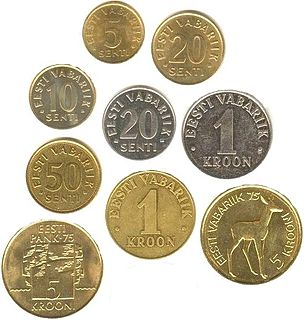
The kroon was the official currency of Estonia for two periods in history: 1928–1940 and 1992–2011. Between 1 January and 14 January 2011, the kroon circulated together with the euro, after which the euro became the sole legal tender in Estonia. The kroon was subdivided into 100 cents. The word kroon is related to that of the Nordic currencies and derived from the Latin word corona ("crown"). The kroon succeeded the mark in 1928 and was in use until the Soviet invasion in 1940 and Estonia's subsequent incorporation into the Soviet Union when it was replaced by the Soviet ruble. After Estonia regained its independence, the kroon was reintroduced in 1992 and replaced by the euro in 2011.
The Latin Monetary Union (LMU) was a 19th-century system that unified several European currencies into a single currency that could be used in all member states when most national currencies were still made out of gold and silver. It was established in 1865 and disbanded in 1927. Many countries minted coins according to the LMU standard even though they did not formally accede to the LMU treaty.
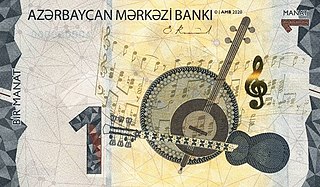
The manat is the currency of Azerbaijan. It is subdivided into 100 qəpik.
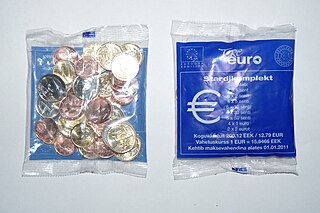
Estonian euro coins feature a single design for all eight coins. This is a design by Lembit Lõhmus and features a silhouette map of Estonia together with the word Eesti (Estonia) and twelve stars, symbolic of the European Union, surrounding the map. This was the winning design in a public vote of ten announced in December 2004.
The colón was the currency of El Salvador from 1892 until 2001, when it was replaced by the U.S. dollar during the presidency of Francisco Flores. The colón was subdivided into 100 centavos and its ISO 4217 code was SVC. The plural is "colones" in Spanish and the currency was named after Christopher Columbus, known as Cristóbal Colón in Spanish.

Bank of Estonia is the central bank of Estonia as well as a member of the Eurosystem organisation of euro area central banks.

Rein Otsason was an Estonian banker.
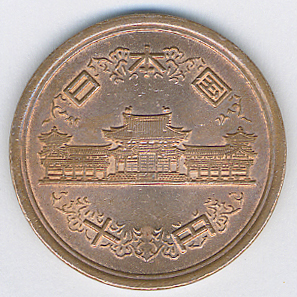
The 10 yen coin is one denomination of the Japanese yen.

Money is any item or verifiable record that is generally accepted as payment for goods and services and repayment of debts, such as taxes, in a particular country or socio-economic context. The main functions of money are distinguished as: a medium of exchange, a unit of account, a store of value and sometimes, a standard of deferred payment. Any item or verifiable record that fulfils these functions can be considered as money.

The 500 krooni banknote is a denomination of the Estonian kroon, the former currency of Estonia. Carl Robert Jakobson (1841–1882), who was an Estonian politician, publisher, writer and promoter of agriculture, is featured on the front side of the bill, which is why the 500 krooni bill is often called a "Jakobson".

The 100 krooni banknote is a denomination of the Estonian kroon, the former currency of Estonia. Lydia Koidula (1843–1886), who was an Estonian poet and playwright, is featured on the front side of the banknote, which is why the 100 krooni banknote is often called a "Koidula".

The 50 krooni banknote is a denomination of the Estonian kroon, the former currency of Estonia. A portrait of Rudolf Tobias (1873–1918), a famous Estonian composer, is engraved on the front side of the bill along with the pipe organ of the Käina church.

The 10 krooni banknote is a denomination of the Estonian kroon, the former currency of Estonia. Jakob Hurt (1839–1907), who was an Estonian folklorist, theologian, linguist and prominent social figure during the Estonian national awakening in the 19th–20th century, is featured with an engraved portrait on the obverse side of the banknote. The 10 krooni bill is sometimes called a "Hurt".

The 5 krooni banknote is a denomination of the Estonian kroon, the former currency of Estonia. Paul Keres (1916–1975), who was a world-famous Estonian chess player, international Grandmaster and prominent chess theorist, is featured with an engraved portrait on the obverse.

The 2 krooni banknote is a denomination of the Estonian kroon, the former currency of Estonia. Karl Ernst von Baer, who was an Estonian Baltic German anthropologist, naturalist and geographer (1792–1876), is featured with a portrait on the obverse. The 2 krooni bill is called sometimes a "kahene" meaning "a two".
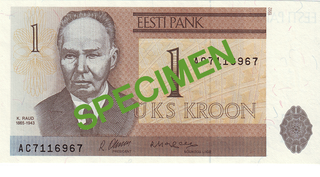
The 1 kroon is the smallest valued banknote of the Estonian kroon, the former currency of Estonia. Kristjan Raud (1865–1943), an Estonian painter, teacher, and cultural historian, is featured with a portrait on the obverse. A view of Toompea Castle in Tallinn appears on the reverse.
Günther-Friedrich Reindorff was an Estonian graphic designer, book illustrator, and educator. He designed many postage stamps series, a large number of military insignia and bookplates, diplomas, various advertising sheets and currency in the late 1920s and early 1930s.

5 lats coin was a Latvian lat coin minted in 1929, 1931 and 1932. It became a popular symbol of independence during the Soviet occupation. It was reproduced in several modern commemorative coins of Latvia and is used on the national sides of the Latvian 1 and 2 euro coins. The reverse design was featured on the 500 lats banknote and in watermarks of all lats banknotes.
The 50 sen coin (五十銭硬貨) was a Japanese coin worth half of a Japanese yen, as 100 sen equalled 1 yen. These coins circulated from the late 19th century to the early 1950s, when Japan adopted a single currency unit and this coin was demonetized.
References
- ↑ Kaunimmunt. "Eesti Vabariik 1 krooni 1934" (in Estonian). Kaunimmunt. Archived from the original on 2012-02-23. Retrieved 1 February 2013.
- ↑ Eesti Bank (2010). EESTI KROON I (PDF) (in Estonian). Eesti Bank. p. 21. Archived from the original (PDF) on 2019-05-03. Retrieved 2020-03-08.
- 1 2 Keller, A. (26 July 1934). "Department of Economics of the Ministry of Finance". Nr. 123/L.
- ↑ Eesti Bank (2010). EESTI KROON I (in Estonian). Eesti Bank. pp. 23–24.
- 1 2 3 Eesti Bank (2010). EESTI KROON I (PDF) (in Estonian). Eesti Bank. p. 17. Archived from the original (PDF) on 2019-05-03. Retrieved 2020-03-08.
- 1 2 Dotan, Yossi (2007). Europe 1800-2005. Sussex Academic Press. p. 30. ISBN 978-1898595496.
- ↑ Kooli, Holstre. "Meenutusi Eesti kroonist". Holstrekool. Retrieved 1 February 2013.
- ↑ Moneta gallery coin museum. "Estonia 1 Kroon - Knorr". Moneta. Retrieved 1 February 2013.
- ↑ "Coins of Estonia: At the threshold of the monetary reform". unusualcoins.ee. Archived from the original on 2013-02-17. Retrieved 4 February 2013.
- ↑ "1934 Kroon Crowned King of Coins in Contest". Eesti Rahvusringhääling . Retrieved 4 February 2013.